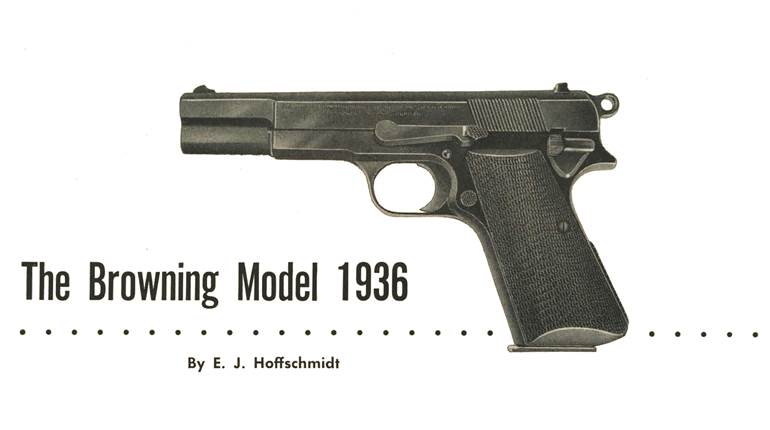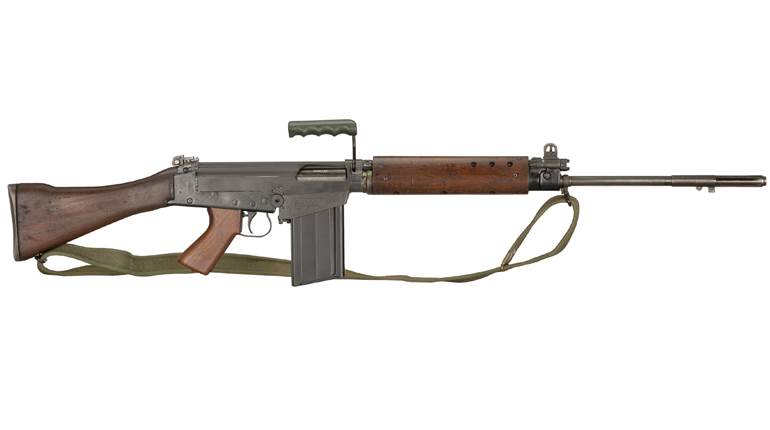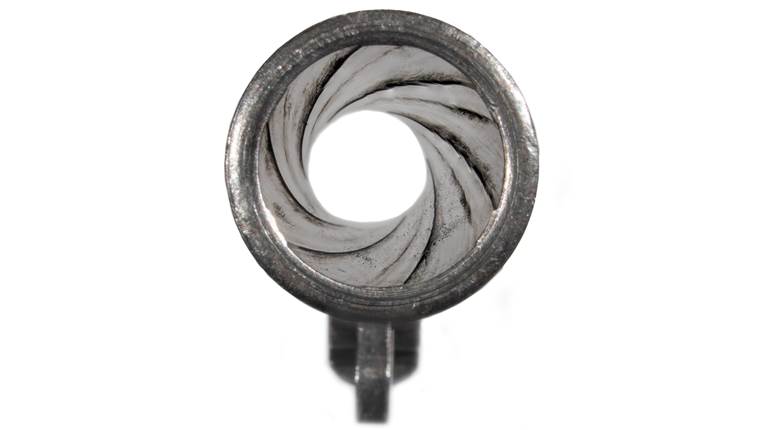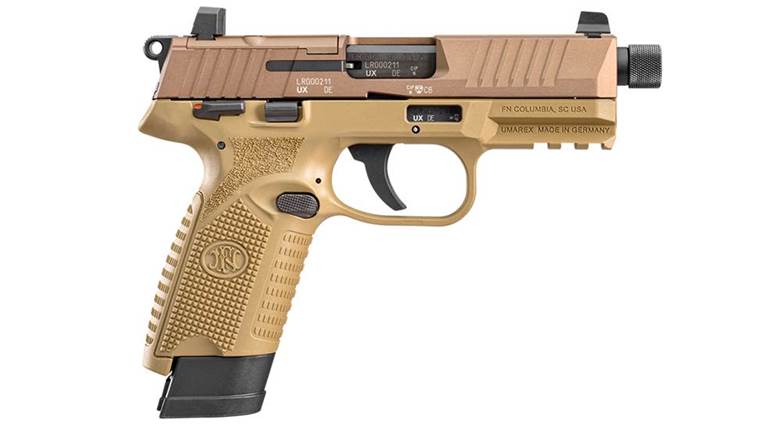
Clockwise from center-top: 1930s Yugoslav officer’s pistol; September 1944 pistol assembled during the first days of liberation when FN had no power, with parts left in the white; pre-war French municipal police pistol for Toulouse; pre-war, gold-engraved presentation pistol as owned by President Martinez from El Salvador; pre-war RPLT Danish police pistol; pre-war Greek Army pistol and pre-war TC Subay Turkish army pistol. Also pictured are various 1920s and 1930s factory instruction books, FN ammunition boxes, a pre-war commercial holster made by Fonson in Brussels, a pre-war Dutch army double magazine pouch, post-war Belgian police shooting prizes depicting the FN Model 1922, an FN cleaning rod and a rear-sight adjustment tool with two FN dummy cartridges.
The Great War devastated the nation of Belgium and its industry. The Fabrique Nationale (FN) factory laid mostly idle during the war. Machinery had been looted, and finished products such as guns, automobiles and motorcycles were requisitioned by German forces during the occupation. Additionally, the years 1919 and 1920 were dominated by hyperinflation, scarcity of raw materials and labor shortages. Millions of Belgians worked for the war effort in France, England and the United States, and it took time for these workers to find their way home. Others had perished or been disabled during the war.
Despite those challenges, FN was no longer restricted in the products it could manufacture, as had been the case when the DWM company held majority ownership in FN (1896-1918).
The post-war military market was flooded with war surplus, and FN focused on sales markets far removed from the war. Rekindling relationships with Central and South American buyers was a priority. FN’s first post-war military design was the Model 1922 Mauser rifle, but it proved to be a failure. It was intended for the South American market, but the length of the rifle was antiquated and reminiscent of 19th-century designs.

A purchasing commission from the newly formed nation of the Kingdom of Serbs, Croats and Slovenes (to become Yugoslavia in 1929) came to the rescue. After independence, the country’s military assessed that it had no less than 20 pistol and revolver models on hand—a logistical nightmare even in peacetime. The commission’s desire was to standardize all handguns to one common Browning model. FN demonstrated the military Model 1903 pistol, but the price of the gun was deemed to be objectionable. The FN Model 1910 pistol had just been adopted by the Belgian military (1919), but the commission desired a more substantial model with raised sights, so FN invited it to collaborate on the development of a new pistol.
John Browning had spent years at FN by the time he designed the Model 1910 pistol in 1907; this model was not just another Browning invention, it was specifically designed for FN and its production capabilities. Browning knew how labor-intensive the FN Model 1900 was to produce and designed the Model 1910 as part of an interchangeable-parts platform based on the FN Model 1905 (1906) Vest Pocket. Not only did the Model 1905 (1906) and Model 1910 share parts, both models used the same machinery in manufacturing. The famous “Triple Safety” (grip, slide and magazine safeties) had been conceived by John Browning, FN and the Belgian inventor Georges Vander Haeghen. It was revolutionary for pocket pistols and a great marketing tool.
FN’s biggest asset of the Model 1910 was the ability to offer the gun in two chamberings simply by interchanging the barrel. Internally, FN management and John Browning referred to it as the “pistol with two barrels,” and Browning already envisioned military sales in 1909 with a longer barrel. He also invented the 9 mm Short cartridge for the FN Model 1910 interchangeable-barrel platform; this information is not widely known, as the cartridge became a commercial success as the .380 ACP long before the Model 1910 was released in 1912.
Cartridge flexibility and production commonalities resulted in substantial savings. Expanding on Browning’s platform was the way FN could develop the Model 1922 within the kingdom’s budget.

Initially, a longer barrel and slide were mounted on a Model 1910 frame, but this proved to be unsatisfactory. A multitude of prototypes were made with various slide, frame, magazine and barrel-lug dimensions. Ultimately, the commission opted for an extended frame and magazine holding two additional rounds and a 25 mm (1") longer barrel with a slide and barrel cap configuration with raised sights. The result became the FN Model 1922: a simple, reliable, safe and affordable striker-fired Browning pistol that retained all the mechanical aspects of the proven Model 1910.
The kingdom was pleased with the model and placed an initial order for 60,000 pistols in 9 mm Short. The commission was thrilled about the development, and that led to talks about a new Mauser short rifle; once the pistol production started, the commission stayed on to supervise production and development of what would become the Model 1924 Mauser. These contracts brought much needed revenue to FN and were the first large-scale military contracts after World War I.
The Kingdom of Serbs, Croats and Slovenes’ FN Model 1922 contract was the springboard to some of FN’s greatest contracts of all time, notably the Dutch acquisitions. In 1925, the Netherlands purchased 2,000 pistols in 7.65 mm Browning (.32 ACP) for law enforcement. The pistols were a success and drew the attention of the Dutch military. An issue with ammunition primers steered the Dutch military to select the 9 mm Short pistol instead of the 7.65 mm version. Early Dutch law enforcement 7.65 mm Browning pistols were later converted to 9 mm Short by installing new barrels. The original 7.65 mm magazines were retained, as the only difference between the two magazines are the amount of view holes, despite their cartridge markings. Military and law-enforcement pistols were purchased annually, according to a structured purchasing plan. The Dutch military alone purchased more than 60,000 by 1940. All Dutch military and law-enforcement departments were equipped with either FN Model 1922 or 1910 pistols. The Dutch went on to purchase both models for almost 60 years!

FN offered the base model in either chambering with a multitude of options, including property markings, crests, contract numbers, lanyard rings and a blue or resilient black-enamel finish, not to mention an array of available accessories. Buyers could configure options according to their budget, and it quickly became a favorite throughout Europe. The governments of Greece, France, Romania, Turkey, Finland and Denmark all purchased the model for military or law-enforcement use, or both, during the pre-war era.
It is of no surprise that the model was manufactured for the German military during World War II; the High Power and Model 1922 were the only FN pistols manufactured during the occupation. The Germans assembled pre-war parts into pistols in 1940—these were mostly in 9 mm Short. New production followed, but only in 7.65 mm Browning. Both FN pistol models were used extensively by all branches of the German military; it is a misconception that the Model 1922 was used exclusively by the Luftwaffe or Luftwaffe pilots.
The simplicity of the Model 1922 made it much easier to manufacture, and wartime production numbers exceeded the High Power by almost 50 percent. The quality of FN products declined as the war progressed, as raw materials grew scarce; the Germans replaced the pre-war horn stocks early on with synthetic stocks, and those, in turn, were substituted with wood and later with less-suitable Bakelite material. The Model 1922 was not targeted with sabotage, instead the resistance focused its efforts on combat arms, like 98k parts and High Power production. Also, Model 1922 pistols and parts were smuggled out of the factory to arm resistance groups.

Production had become erratic by the spring of 1944, and the Germans made plans to move High Power and Model 1922 manufacturing to Germany. While much of FN’s machinery was dismantled, Allied air superiority made transporting entire production lines to Germany impossible. The rapid Allied advance further thwarted plans, and the Germans abandoned some finished pistols and thousands of parts.
FN management and resistance members secured the factory within minutes of the German departure. Uncertainty filled the air, as there was anxiety that German troops could return en masse. Workers immediately started assembling pistols; the prevailing idea was to quickly supply arms to resistance and Allied forces.
When elements of the U.S. 3rd Armored Division engaged Germans on the south side of Liège (Sept. 7, 1944), residents put on their Sunday best to welcome the Americans. People cheered and watched in disbelief as American armor rolled through city streets. American military might left such an impression that residents still talked about it decades later. Assembling pistols to arm Allied soldiers now seemed futile, but the word of a local arms factory quickly spread among American G.I.s and, within days, soldiers were lining up to buy those models that had been issued to German troops. Many believed that the pistols were marked with the “Browning” name as a sales gimmick!
American G.I.s brought optimism, security, freedom and much-needed revenue to the factory and its workers. Soldiers bought thousands of FN Model 1922 and High Power pistols. The pistols were the only guns FN could assemble in large quantities at that time.
Soon after the liberation, FN anticipated receiving government orders, as all law-enforcement agencies throughout occupied Europe were stripped of sidearms. Communities and corporations were the first to buy the Model 1922 in 1944 for their law-enforcement and security personnel. Centralized purchases from the Belgian government only came much later. The large quantities of leftover occupation parts put FN in a unique position of being able to supply pistols after liberation. French, Dutch, Belgian and Danish governments placed orders in 1945 for FN Model 1922 pistols to re-arm their law-enforcement officers. The Belgian military also adopted the pistol out of necessity; it had not been adopted in the pre-war era, as is often believed.

FN had struggled in the pre-war years to sell to the French government. Prejudice toward foreign-made products always influenced the decision-making process to the extent that the French conceived the MAB Model B after the French navy adopted the FN Model 1922, an effort to divert future orders to French industry. Necessity forced a change in attitude in 1945; the French government purchased the popular FN Model 1922 by the thousands, with many remaining in service into the 1980s.
But no other nation’s orders came close to the Dutch in terms of either purchase quantities or frequencies. The model became iconic in the Netherlands, and the Dutch were further involved with the evolution of the design in the 1970s with the modernized Model 120 and 125. FN eventually discontinued the Model 1922 in 1983, although spare parts remained available. More than 500,000 were produced in peacetime compared to an estimated 448,000 made during the German occupation.
The popularity of the FN Model 1922 continues today, with varying contracts and markings that delight and fascinate collectors.

Anthony Vanderlinden is the author of FN Browning Pistols, Sidearms That Shaped World History. The book’s much expanded third edition contains 840 pages in a two-volume set. Price: $150 plus shipping. (NRA members receive an autographed set and $10 discount with code NRA.) Contact: Wet Dog Publications; (336) 394-4138; (fnbrowning.com).






































